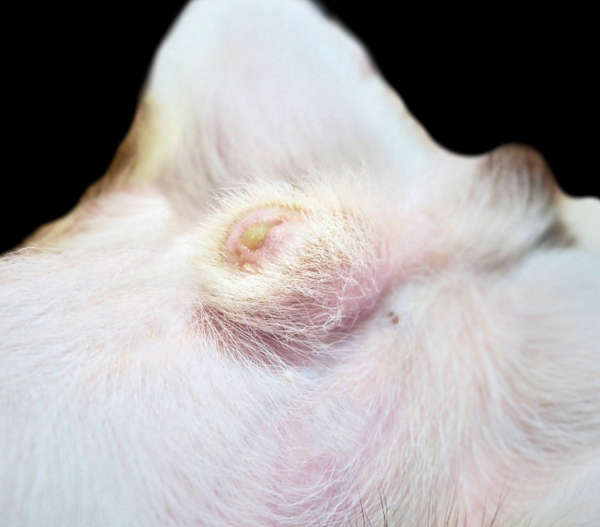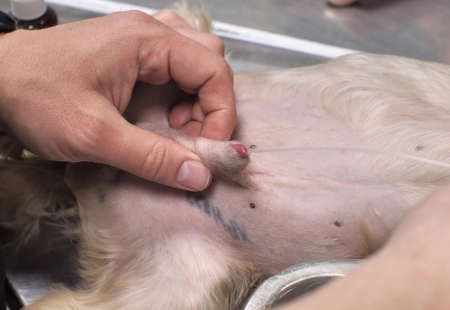
This article was updated on February 2nd, 2024
First-time owners of male dogs sometimes call my clinic asking about a creamy, yellowish-white substance around their furbaby’s sheath or underbelly. I would explain that the discharge is called smegma, and it’s natural. However, there are times when smegma can cause problems.
In this article, I’ll explains signs of segma infection, top causes and what you can do to help your dog. I’ll also let you know when it’s time to call your vet and how much the visit may cost.
What is a smegma infection in dogs?
Let’s start with a definition of smegma. This normal biological discharge is a collection of dead skin cells and glycoproteins that help to lubricate your dog’s penis. It’s usually yellow-white to green in color. All ages of male dogs produce smegma, but the amount of output increases after puberty.

If you have a male dog, you can expect to occasionally see a little smegma. But when the smegma builds up, it provides a media where bacteria and yeast can grow. This results in an infection that can impact the penis and prepuce which is painful for your dog.
Top causes of smegma infections
Various causes of smegma buildup can lead to infections in dogs.
1. Poor hygiene

When smegma collects at the end of your dog’s penis or prepuce, it needs to be cleaned. Sometimes, your pup will lick it to clear the discharge, but if he doesn’t, bacteria or yeast can proliferate.
Fortunately, you can help your dog by gently washing his genital area with warm salt water or non-irritating soap. Cleaning the area once a week should be enough to prevent smegma buildup and infection, but it may vary depending on your dog’s breed and size. Always pay special attention to long hair and skin folds in the area.
2. Allergies/inflammation
Food sensitivities and environmental allergies in dogs can cause skin inflammation. When allergic reactions irritate the penis and prepuce area, it can trigger increased smegma production and buildup.
Food or environmental allergies may be characterized by:
- Inflamed, red skin/rash
- Hives
- Extreme itching
- Constant licking
- Vomiting /diarrhea
If you or your veterinarian suspect a food allergy, you can try an elimination diet to isolate the offending allergen. For environmental allergies, the doctor may prescribe anti-inflammatory medications.
3. Hormonal imbalances
Certain hormones influence your dog’s smegma production. If there’s an imbalance in hormones like testosterone, it may cause your pooch to manufacture more smegma than usual. In turn, the increased levels make your pooch more prone to buildup and infection.
Elevated levels of testosterone can also cause benign prostatic hyperplasia(BP. The best treatment for BPH is neutering.
4. Skin infections
Also known as dermatitis, a skin infection can cause inflammation and irritation around the prepuce. Your dog may also lick or scratch the infected areas. This stimulates the penis to produce extra smegma. The result is smegma buildup and infections.
Treatment for skin infections depends on the cause of the irritation. Your veterinarian can evaluate the nature of the inflammation and take skin cultures to determine if the pathogen is bacteria or yeast. Depending on the diagnosis, he will prescribe antibiotics or antifungal treatments and possibly anti-inflammatory medications to resolve the condition. Learn more about skin infections (pictures, diagnosis and treatments).
5. Urethral obstruction
The male dog is long and curvy, and when it passes through a bony trough(os penis) in the penis, the tube gets narrower. If your dog has bladder or urine stones, they can get caught in the narrow part of the urethra causing an obstruction. Tumors or a broken os penis can also cause a complete or partial occlusion.
When dogs suffer a urethral obstruction, you may notice the following symptoms.
- Inappropriate urination around the house
- Dribbling urine
- Straining to urinate
- Blood in the urine
- Peeing more frequently in smaller quantities
Because your dog is going more frequently, the body may produce extra smegma to keep the penis lubricated. If the materials build up, infection is likely.
To treat a urethral obstruction, your veterinarian will attempt to flush or catheterize the penis to push the stones back into the bladder. Then, he will surgically remove the calculi and either attempt to dissolve the stones medically or pulverize them with ultrasound or lasers.

If the obstruction cannot be reversed (often the case if your dog has a tumor), the vet may need to surgically reroute the urethra to exit the scrotum. Prognosis is good for animals that receive treatment.
When to worry about an infection
Smegma is normal in male dogs. However, you should talk to your vet if:
- Your dog’s smegma turns a different color than usual
- The smegma has a foul odor
- Smegma suddenly starts accumulating more than usual
- The area around the penis is red or inflamed
- Urination is painful for your dog
- Your dog’s urination habits suddenly change
- There’s blood in the urine
When you notice the above signs, it may indicate your dog has an infection or another medical condition.
Symptoms of smegma infections
In addition to the changes noted above, dogs with smegma infections may have other symptoms:
- Excessively licking/grooming the genital area
- Excessive discharge from the penis
- Loss of appetite/lethargy
- Straining to urinate
Diagnosis at the vet
When you suspect that your dog has a smegma infection, schedule an appointment with your veterinarian. At the clinic, the doctor will ask questions about your dog’s behavior and symptoms, conduct a physical examination including the penis and prepuce, and run diagnostic tests that may include blood work, urinalysis, X-ray or ultrasound to check for obstructions or tumors, and/or collecting and culturing a smegma sample.
When you take your dog to the vet, you may have the following expenses:
- Office visit and examination – $100-150
- Blood tests – $75-100
- Urinalysis – $25-50
- X-rays – $150-250
- Ultrasound – $300-600
- Antibiotics – $20 or more depending on the antibiotic
- Urinary tract obstruction treatment – $400-1200+ depending on the severity.
What can I do when a smegma infection happens in my dog?
If you notice smegma buildup and irritation around your dog’s prepuce, you can help reduce inflammation with proper hygiene. Usually, your furbaby will keep the area clean, but if he’s not doing an adequate job, you should follow these steps:
1. Collect your supplies
Before you start, have everything in place. You will need a gentle, pet-safe antibacterial soap, warm water, and clean towels or gentle cleansing wipes. If you choose, you can also have a pair of gloves handy.
2. Prepare your dog
Select a comfortable place to clean your dog, particularly if they’re not accustomed to it. Start by lightly touching around the prepuce and reassuring your furbaby with treats if he seems anxious.
You may also elect to give your dog a warm bath first and clean the genital area at the end of bathing. If you take this approach, use a gentle, dog-safe shampoo to clean his fur and body.
3. Clean the genital area
Use a dog-safe puppy wipe or a damp, clean, soft cloth to clean your dog’s genitals. Start with the penis. Gently push back the prepuce and remove any smegma using the wipe or a damp cloth and pet-safe soap. Do not insert any cleaner into the sheath.
Rinse the area thoroughly to remove all soap traces and then replace the sheath so that it fully covers the penis. Finish by washing and rinsing the prepuce. Be careful to clean between any skin folds.
4. Dry the genital area
You can use a clean, soft towel to gently pat the genital area dry. Then, let your dog rest in a clean, dry area until he’s completely dry.
5. Reward your dog
When you’re done cleaning the genital area, treat and praise your dog to reinforce that it’s a positive experience.
6. Monitor your dog
After you clean your dog’s genital area and remove the smegma, observe him for any signs of trouble like redness, swelling, or pain. Call your vet if you notice any concerning symptoms.
Best products to help at home
Veterinary Formula Clinical Care Antiseptic Medicated Shampoo
Veterinary Formula is a gentle antiseptic shampoo/soap that’s formulated to clean and soothe irritated skin. It’s pH balanced for your pooch, and it contains ingredients that help to break down smegma buildup and inhibit the growth of fungi or bacteria. Test the shampoo on a small patch of skin to check for any sensitivities before you apply it to the genital area.
Burt’s Bees Multipurpose Grooming Wipes for Pets
If you choose to use pet wipes to clean smegma from your dog’s genitals, this product should be gentle and safe. It’s pH balanced for dog skin and uses gentle cleansers that are mostly derived from natural ingredients.
SkinSmart Antimicrobial Skin and Wound Care
After you wash and rinse the genital area, you can apply this antimicrobial spray to eliminate any bacteria or yeast that may be causing increased smegma production. This spray is gentle and safe for sensitive areas.
Frequently asked questions
What can I do to prevent future smegma infections in my dog?
The best way to prevent smegma infections in your dog is by practicing regular grooming. Some of the steps you can take include:
- Clean your dog’s genitals regularly(generally once per week) to prevent buildup
- Trim the hair around the genital area to prevent smegma accumulation
- Manage your dog’s weight
- Treat skin allergies or other underlying skin conditions
- Neutering your dog to reduce smegma production(not always effective)
Are all dogs prone to smegma infections?
Both male and female dogs naturally produce smegma, but it’s usually not a problem. Intact male dogs are more prone to have a buildup of smegma that can lead to infections.
Can smegma infections be infectious to humans?
Smegma infections are not infectious to humans. The condition is caused by a buildup of smegma and bacteria in the dog’s urinary tract or prepuce.
Can smegma infections be treated at home?
Minor smegma buildup can be treated at home with gentle cleaning and antimicrobial agents. If you notice signs of infection such as a foul odor, changes in color, and swelling/inflammation, you should contact your veterinarian. He can examine your dog, diagnose the underlying cause, and formulate the appropriate treatment plan.
Is a smegma infection a serious condition?
Smegma infections in dogs are usually easy to treat and resolve. However, if they’re left untreated, the infections can cause irritation and itching. Over time, the infections can spread and cause serious health conditions.
Related posts:
Disclaimer: This website's content is not a substitute for veterinary care. Always consult with your veterinarian for healthcare decisions. Read More.




Be the first to comment